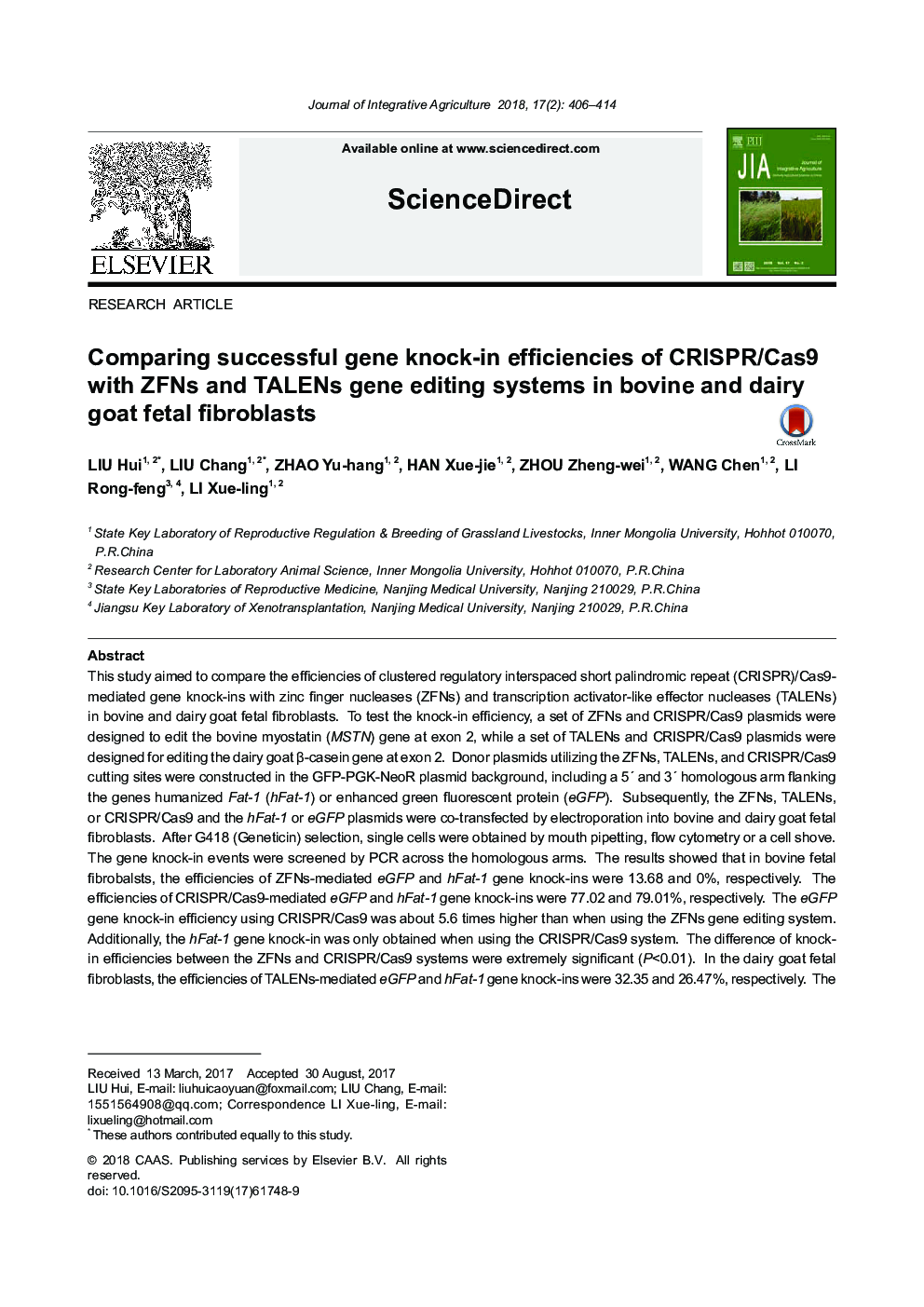| Article ID | Journal | Published Year | Pages | File Type |
|---|---|---|---|---|
| 8875714 | Journal of Integrative Agriculture | 2018 | 9 Pages |
Abstract
This study aimed to compare the efficiencies of clustered regulatory interspaced short palindromic repeat (CRISPR)/Cas9-mediated gene knock-ins with zinc finger nucleases (ZFNs) and transcription activator-like effector nucleases (TALENs) in bovine and dairy goat fetal fibroblasts. To test the knock-in efficiency, a set of ZFNs and CRISPR/Cas9 plasmids were designed to edit the bovine myostatin (MSTN) gene at exon 2, while a set of TALENs and CRISPR/Cas9 plasmids were designed for editing the dairy goat β-casein gene at exon 2. Donor plasmids utilizing the ZFNs, TALENs, and CRISPR/Cas9 cutting sites were constructed in the GFP-PGK-NeoR plasmid background, including a 5' and 3' homologous arm flanking the genes humanized Fat-1 (hFat-1) or enhanced green fluorescent protein (eGFP). Subsequently, the ZFNs, TALENs, or CRISPR/Cas9 and the hFat-1 or eGFP plasmids were co-transfected by electroporation into bovine and dairy goat fetal fibroblasts. After G418 (Geneticin) selection, single cells were obtained by mouth pipetting, flow cytometry or a cell shove. The gene knock-in events were screened by PCR across the homologous arms. The results showed that in bovine fetal fibrobalsts, the efficiencies of ZFNs-mediated eGFP and hFat-1 gene knock-ins were 13.68 and 0%, respectively. The efficiencies of CRISPR/Cas9-mediated eGFP and hFat-1 gene knock-ins were 77.02 and 79.01%, respectively. The eGFP gene knock-in efficiency using CRISPR/Cas9 was about 5.6 times higher than when using the ZFNs gene editing system. Additionally, the hFat-1 gene knock-in was only obtained when using the CRISPR/Cas9 system. The difference of knock-in efficiencies between the ZFNs and CRISPR/Cas9 systems were extremely significant (P<0.01). In the dairy goat fetal fibroblasts, the efficiencies of TALENs-mediated eGFP and hFat-1 gene knock-ins were 32.35 and 26.47%, respectively. The efficiencies of eGFP and hFat-1 gene knock-ins using CRISPR/Cas9 were 70.37 and 74.29%, respectively. The knock-in efficiencies difference between the TALENs and CRISPR/Cas9 systems were extremely significant (P<0.01). This study demonstrated that CRISPR/Cas9 was more efficient at gene knock-ins in domesticated animal cells than ZFNs and TALENs. The CRISPR/Cas9 technology offers a new era of precise gene editing in domesticated animal cell lines.
Keywords
Related Topics
Life Sciences
Agricultural and Biological Sciences
Agricultural and Biological Sciences (General)
Authors
Hui LIU, Chang LIU, Yu-hang ZHAO, Xue-jie HAN, Zheng-wei ZHOU, Chen WANG, Rong-feng LI, Xue-ling LI,
